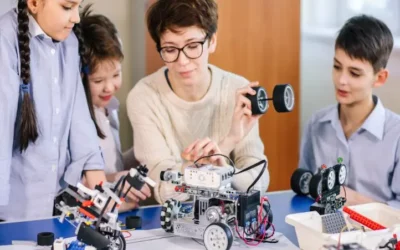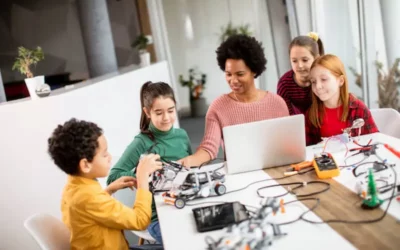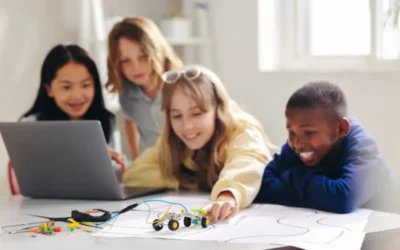Virtual Reality (VR) has taken the world by storm, offering an exciting avenue for kids to explore education like never before. Did you know that the concept of VR dates back to the 1960s?
However, it’s only in recent years that this technology has truly evolved into a powerful tool, especially in the field of education. This article delves into the captivating realm of Virtual Reality for kids, shedding light on how it’s revolutionizing education and providing transformative learning experiences.
Table of contents
- Introduction to Virtual Reality (VR)
- The Immersive Potential of Virtual Reality
- How Kids Learn through Virtual Reality
- Educational Experience in Virtual Reality
- Virtual Reality as an Engaging Teaching Tool
- Ensuring Safe and Responsible VR Usage for Kids
- Overcoming Challenges in Implementing VR for Kids
- Future Possibilities of Virtual Reality in Education
- Simulated Experiences: A Gateway to Real-world Learning
- Immersive Education: Beyond Traditional Classroom Settings
- Navigating Ethical and Cultural Considerations
- Interactive Virtual Learning: Collaboration and Communication
- Virtual Reality for Kids with Learning Differences
- The Role of Educators in VR-based Learning
- Measuring Success and Impact of VR Education
- Parental Involvement and Support in VR Education
- Addressing Myths and Misconceptions about VR for Kids
- Collaborative Learning and Socialization in VR
- Conclusion
- Frequently Asked Questions
Introduction to Virtual Reality (VR)
Virtual Reality, often referred to as VR, immerses users in a digital world that stimulates their senses, making them feel as if they are truly present in that environment. This technology has come a long way from its early experiments to the cutting-edge headsets available today. Kids today have the opportunity to explore historical events, distant lands, and even microscopic worlds through this engaging medium.
How VR Technology is Revolutionizing Education
Imagine learning history by virtually stepping into historical events or grasping complex scientific concepts through immersive visualizations. VR technology is a game-changer in education, providing interactive and experiential learning that engages children’s minds and fosters a deeper understanding of subjects.
Benefits of Incorporating VR into Children’s Learning
The benefits of integrating VR into children’s game education are manifold. It sparks curiosity, enhances retention, and nurtures a love for learning. This technology transcends the limitations of traditional classroom methods, accommodating various learning styles and captivating even the most reluctant learners.
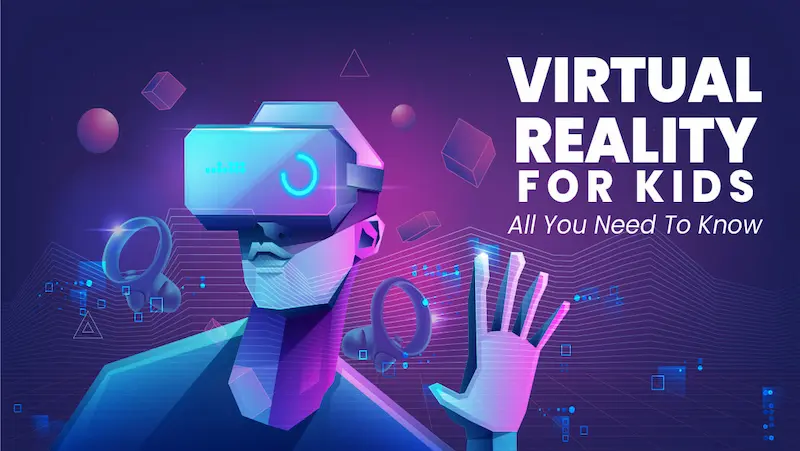
The Immersive Potential of Virtual Reality
Creating Engaging Environments through VR
VR opens the doors to limitless possibilities for creating engaging and captivating learning environments. Whether it’s exploring ancient civilizations, diving into the depths of the ocean, or venturing into outer space, VR allows kids to embark on educational journeys that are both captivating and enriching.
Simulating Real-life Experiences for Kids
Imagine children walking with dinosaurs or witnessing historic moments unfold before their eyes. VR bridges the gap between textbooks and real-life experiences, making learning not just informative but deeply memorable.
Fostering Emotional Connection and Empathy
VR has the incredible power to foster emotional connections and empathy by putting kids in others’ shoes. Whether it’s experiencing life in a different era or understanding the challenges faced by individuals with different abilities, VR cultivates empathy and broadens horizons.
How Kids Learn through Virtual Reality
Cognitive Development and VR Learning
Cognitive development in children is greatly enhanced by the interactive and immersive nature of VR learning. It stimulates their sensory and cognitive functions, making learning a multisensory experience that is both engaging and effective.
Enhancing Critical Thinking and Problem-Solving
VR challenges kids to think critically and solve problems in virtual scenarios. Whether it’s deciphering clues in a historical mystery or conducting virtual science experiments, this technology nurtures vital problem-solving skills.
Expanding Creativity and Imagination
By offering interactive and imaginative experiences, VR encourages kids to think outside the box and explore their creativity. It’s not just about absorbing information; it’s about actively participating and creating within virtual worlds.
Educational Experience in Virtual Reality
Gamification of Learning in VR
Learning through play is a fundamental aspect of childhood education, and VR takes gamification to the next level. Kids can learn math by solving puzzles, history by completing quests, and science by conducting virtual experiments.
Interactive Lessons and Virtual Field Trips
VR allows kids to go beyond textbooks and experience virtual field trips that take them to far-off places, historical landmarks, and even microscopic realms. It transforms passive learning into an interactive adventure.
Tailoring Education to Individual Learning Styles
Every child learns differently, and VR adapts to these differences. Whether a child development is a visual, auditory, or kinesthetic learner, VR offers personalized learning experiences that cater to their unique strengths.

Virtual Reality as an Engaging Teaching Tool
Captivating Kids’ Attention through VR
Traditional classroom methods sometimes struggle to hold kids’ attention. VR, on the other hand, captivates young minds with its interactive and immersive nature, ensuring that learning is both enjoyable and effective.
Making Learning Fun and Exciting
Learning shouldn’t be a chore, and VR ensures that it isn’t. Through gamification, exploration, and interaction, VR turns education into an exciting adventure that kids activities eagerly embark upon.
Incorporating Play into Educational VR Content
Play is integral to childhood development, and VR seamlessly integrates education and play. It transforms learning into a joyful experience where kids are active participants in their own educational journey.
Ensuring Safe and Responsible VR Usage for Kids
Setting Age-Appropriate Content and Time Limits
As parents, your child’s safety and well-being are paramount. With VR technology, it’s essential to choose age-appropriate content that aligns with your child’s developmental stage. Many VR platforms offer categorization based on age, ensuring that your child engages with content that’s both educational and suitable. Implementing time limits is also vital to prevent excessive screen time, striking a balance between VR learning and other activities.
Addressing Health and Safety Concerns
Concerns about health and safety in VR are natural. However, studies have shown that, when used correctly and in moderation, VR is generally safe for kids. To mitigate any discomfort, ensure your child takes breaks, stays hydrated, and follows guidelines for VR headset usage. Keep an eye out for any signs of motion sickness, but rest assured that most children adapt quickly to VR experiences.
Parental Control and Supervision in VR Learning
Parental involvement is key to fostering a positive VR experience. Many VR platforms offer parental control features, allowing you to monitor and control your child’s VR activities. Take advantage of these features to ensure your child explores in a safe and supervised manner. It’s also an excellent opportunity for you to engage with your child’s virtual adventures and share in their excitement.
Overcoming Challenges in Implementing VR for Kids
Access and Affordability of VR Technology
While VR technology has become more accessible over time, affordability can still be a concern for some families. However, keep in mind that there are various entry points into the world of VR, from budget-friendly options to more advanced setups. Consider exploring VR arcades or community centers that offer VR experiences, allowing your child to access this transformative technology without a hefty investment.
Training Educators for Effective VR Integration
Integrating VR into educational settings requires trained educators who understand how to leverage its potential fully. Advocating for VR integration in schools and supporting teacher training in VR technology can enhance the quality of education your child receives. By bridging the gap between technology and pedagogy, educators can create immersive and engaging learning experiences that resonate with young minds.
Dealing with Technological and Infrastructure Limitations
Not all schools or homes have the technological infrastructure to support seamless VR experiences. However, don’t let this deter you. As VR technology continues to evolve, it’s likely that more accessible options will emerge. In the meantime, consider collaborating with other parents or educational institutions to share resources and experiences, ensuring that no child is left behind in the VR revolution.
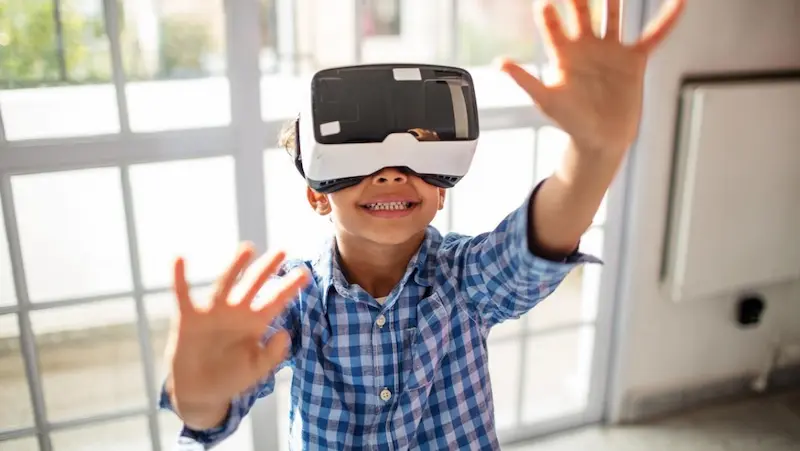
Future Possibilities of Virtual Reality in Education
Advancements in VR Technology for Kids
The future of VR for kids holds exciting possibilities. As technology advances, VR experiences will become more immersive, interactive, and tailored to individual learning styles. Imagine your child exploring ancient civilizations or embarking on virtual field trips to space, all while developing critical thinking and problem-solving skills that will serve them well in the future.
Virtual Reality’s Role in Shaping Future Generations
VR has the power to shape the way future generations learn, interact, and connect with the world. It encourages curiosity, exploration, and empathy, nurturing well-rounded individuals who are equipped to tackle global challenges. By exposing kids to diverse cultures, environments, and perspectives, VR fosters a deep understanding of the world around them.
Collaboration and Social Learning in Virtual Spaces
In virtual environments, kids can collaborate with peers from different corners of the globe, fostering a sense of global community. Through shared experiences and problem-solving tasks, they learn the value of teamwork and communication. These skills are not only essential for their education but also for their personal growth and future careers.
Simulated Experiences: A Gateway to Real-world Learning
Connecting Virtual Lessons to Real-life Applications
One of the remarkable aspects of VR is its ability to bridge the gap between theoretical learning and real-world applications. Imagine your child learning about ecosystems in a textbook and then immersing themselves in a virtual rainforest, interacting with its inhabitants and witnessing firsthand the delicate balance of nature. These simulated experiences make learning tangible and unforgettable.
Inspiring Career Exploration through VR
VR isn’t just about academic subjects; it’s also a tool for sparking career interests. From aspiring astronauts exploring outer space to future architects designing virtual buildings, VR opens doors to various career possibilities. By igniting curiosity and passion, VR can guide kids towards their future professions with a sense of purpose and excitement.
Bridging the Gap between Classroom and Practical Learning
Traditional classrooms often struggle to provide hands-on experiences. VR fills this gap by enabling kids to manipulate objects, conduct experiments, and engage in interactive scenarios. Whether it’s conducting virtual chemistry experiments or stepping into historical events, VR brings learning to life in a way that textbooks alone cannot.
Immersive Education: Beyond Traditional Classroom Settings
Homeschooling and Remote Learning with VR
The recent shift towards homeschooling and remote learning has highlighted the need for innovative educational tools. VR offers a dynamic solution, allowing kids to participate in virtual classrooms, interact with teachers and peers, and access a wealth of educational resources from the comfort of home. It’s a transformative approach to education that adapts to changing times.
Virtual Reality in Special Education and Inclusion
In the realm of special education, VR holds immense potential. It caters to diverse learning styles and abilities, providing personalized experiences that accommodate various needs. Through virtual simulations and interactive lessons, children with special needs can grasp complex concepts, build essential skills, and gain a newfound sense of independence.
Creating Global Learning Communities through VR
VR transcends geographical boundaries, enabling kids from different parts of the world to connect and learn together. This global interaction fosters cultural understanding, empathy, and a broader perspective. By sharing insights and collaborating on projects, children become true global citizens, prepared to navigate an increasingly interconnected world.
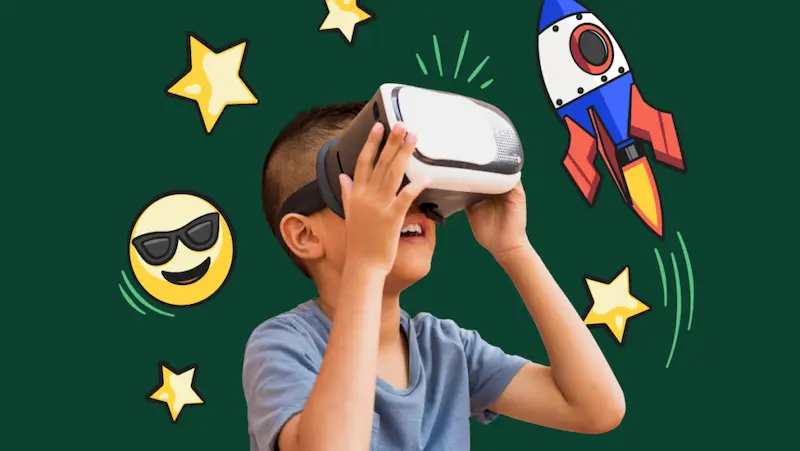
Navigating Ethical and Cultural Considerations
Cultural Sensitivity and Inclusivity in VR Content
As VR becomes a conduit for cultural exploration, it’s crucial to ensure that content is respectful and inclusive of diverse cultures. Choose platforms that prioritize cultural sensitivity and provide accurate representations of different communities. By exposing your child to a variety of perspectives, you nurture open-mindedness and appreciation for cultural diversity.
Addressing Bias and Stereotypes in Virtual Environments
Just like any other media, VR content can sometimes perpetuate biases and stereotypes. Take an active role in reviewing the content your child engages with, and use these instances as opportunities for valuable discussions. Encourage critical thinking and guide your child in recognizing and challenging stereotypes, fostering a more inclusive mindset.
Fostering Respect and Understanding through VR Education
VR’s immersive nature allows children to step into the shoes of others, cultivating empathy and understanding. By experiencing historical events or daily life from different perspectives, kids learn to appreciate the challenges and triumphs faced by various individuals and communities. This empathy lays the foundation for a compassionate and harmonious future.
Interactive Virtual Learning: Collaboration and Communication
Virtual Classrooms and Group Activities
The virtual classroom is a space where imagination meets education. Kids can interact with teachers and classmates, ask questions, and engage in group activities as if they were physically present. This interactive environment promotes active participation and enables children to build relationships with peers while learning together.
Building Interpersonal Skills in Virtual Spaces
Contrary to concerns about technology hindering interpersonal skills, VR can actually enhance them. Through role-playing scenarios and collaborative projects, kids develop communication, negotiation, and conflict-resolution abilities. These skills are transferable to real-life situations, ensuring your child is well-prepared for social interactions.
Encouraging Peer-to-Peer Learning and Knowledge Sharing
In virtual spaces, kids can learn not only from teachers but also from each other. Encourage your child to share their knowledge, skills, and insights with peers, fostering a culture of peer-to-peer learning. This approach not only enriches their learning experience but also boosts their confidence and sense of contribution.
Virtual Reality for Kids with Learning Differences
Personalized Learning Paths in VR
Every child learns differently, and VR accommodates these diverse learning styles. Through adaptive technology, VR can tailor learning experiences to match your child’s strengths and preferences. Whether your child is a visual, auditory, or kinesthetic learner, VR ensures that the learning journey is uniquely theirs.
Supporting Neurodiverse Learners through Immersive Education
For children with learning differences such as ADHD or autism, traditional classroom settings can be challenging. VR provides a less overwhelming environment, reducing sensory overload and creating a controlled space for learning. This enables neurodiverse learners to focus better and engage with educational content more effectively.
Empowering Children with Learning Disabilities through VR
VR has the potential to empower children with learning disabilities by turning challenges into strengths. For example, dyslexic children can benefit from immersive reading experiences that enhance comprehension. By leveraging VR’s capabilities, children with learning disabilities can build confidence, improve skills, and achieve academic success.
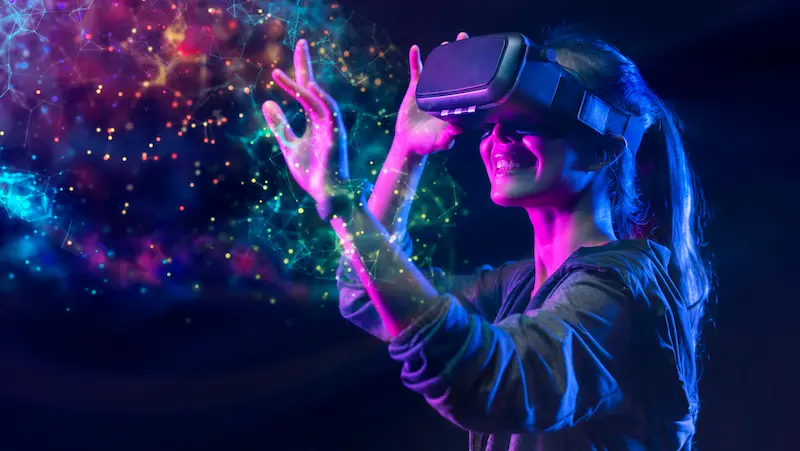
The Role of Educators in VR-based Learning
Facilitating Learning Experiences in Virtual Reality
Educators play a pivotal role in shaping the impact of VR-based learning. A skilled teacher can guide students through immersive experiences, asking thought-provoking questions and fostering critical thinking. By creating meaningful connections between virtual scenarios and real-world concepts, educators help children extract the maximum educational value from VR.
Adapting Teaching Methods for VR Integration
VR requires a shift in teaching methods, focusing on experiential and inquiry-based learning. Educators must adapt their approaches to fully harness VR’s potential. Encourage your child’s school to invest in educator training programs that equip teachers with the skills to integrate VR effectively into curriculum planning.
Partnering with Technology Experts for Optimal Learning Outcomes
Educators don’t have to navigate the world of VR alone. Collaboration between teachers and technology experts ensures that VR experiences are seamlessly integrated into the learning process. By pooling their expertise, educators and tech professionals create immersive educational journeys that captivate and educate young minds.
Measuring Success and Impact of VR Education
Assessing Learning Outcomes and Skill Development
Measuring the success of VR education goes beyond traditional exams. Look for platforms that provide comprehensive assessments, gauging not only academic progress but also the development of critical skills such as problem-solving, creativity, and collaboration. These skills are essential for your child’s holistic growth.
Long-term Benefits of VR-Enhanced Education
The impact of VR education extends far beyond the classroom. Skills acquired through immersive experiences are applicable to various aspects of life, from future careers to personal endeavors. By nurturing a passion for learning and providing a diverse skill set, VR prepares your child for a dynamic and fulfilling future.
Analyzing Student Engagement and Motivation in VR Learning
One of the hallmarks of VR education is its ability to captivate students’ attention. Immersed in virtual worlds, children become active participants in their own learning journey, fostering a deep sense of engagement and motivation. Harnessing this enthusiasm can lead to more enthusiastic learners who take ownership of their education.
Parental Involvement and Support in VR Education
Encouraging Parent-Child Interactions in VR Learning
The role of parents in VR education is invaluable. Engage with your child’s VR experiences by asking questions, showing interest, and participating in their virtual adventures. This involvement not only strengthens your bond but also reinforces the idea that learning is a collaborative endeavor.
Building Trust and Open Communication about VR
Open dialogue about VR is crucial to your child’s positive habits and experience. Create a safe space where your child can share their thoughts, concerns, and excitement. By addressing any fears or misconceptions, you build trust and ensure that VR remains an enriching and safe learning tool.
Resources and Guidelines for Parents to Navigate VR Education
Navigating the world of VR education can be overwhelming, but resources are available to help you make informed decisions. Seek out articles, forums, and workshops that offer guidance on selecting suitable content, setting usage limits, and fostering a healthy relationship with VR. Armed with knowledge, you can confidently guide your child’s VR journey.
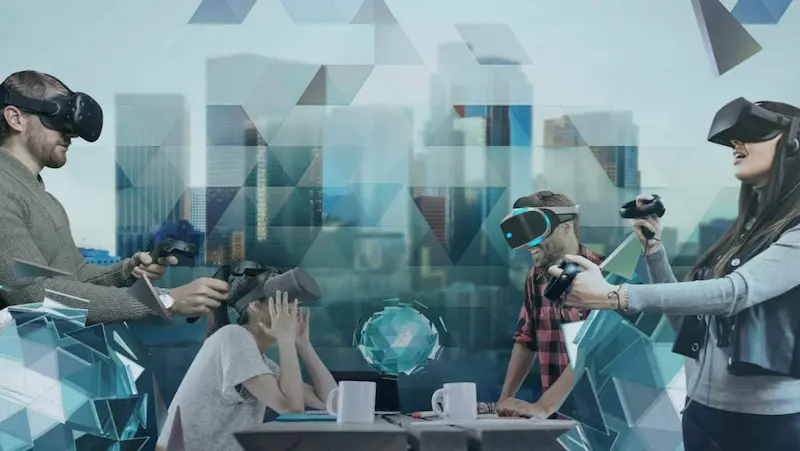
Addressing Myths and Misconceptions about VR for Kids
Separating Fact from Fiction: VR and Child Development
As with any emerging technology, myths and misconceptions surround VR. Separating fact from fiction is essential to make informed choices for your child. Research shows that, when used appropriately, VR can be a valuable tool for enhancing learning and cognitive development.
Debunking Common Concerns and Misperceptions
From fears of stunted social skills to worries about adverse health effects, misconceptions about VR abound. By debunking these concerns through research and expert insights, you can confidently embrace VR’s potential as an educational tool that nurtures creativity, critical thinking, and collaboration.
Evidence-based Insights on the Safety and Educational Value of VR
Evidence-based insights provide a solid foundation for embracing VR education. Numerous studies highlight the positive impact of VR on learning outcomes and cognitive development. By staying informed about the latest research, you can approach VR with confidence and enthusiasm.
Collaborative Learning and Socialization in VR
Virtual Playdates and Social Interaction for Kids
VR isn’t just about individual learning; it’s also a platform for social interaction. Virtual playdates allow kids to connect with friends, engaging in joint activities and adventures. This fosters a sense of camaraderie and ensures that your child’s VR experiences are as social as they are educational.
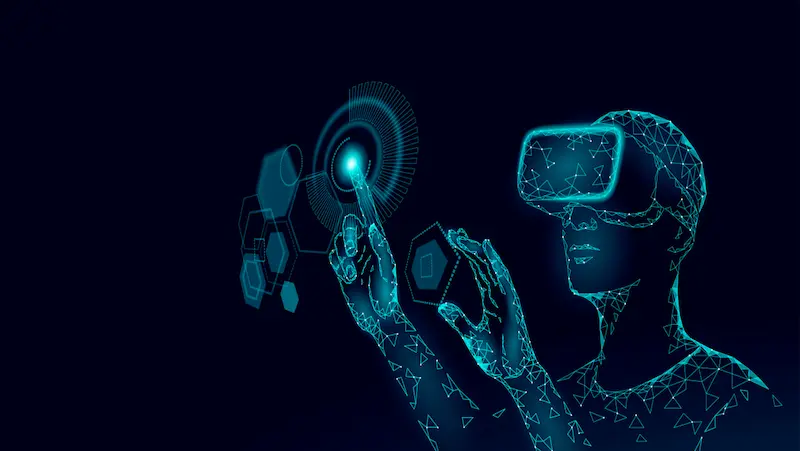
Nurturing Empathy and Cooperation in Virtual Environments
VR has a unique ability to evoke empathy by placing children in the shoes of others. Multiplayer scenarios encourage cooperation, problem-solving, and mutual understanding. These experiences build emotional intelligence, teaching kids the value of empathy and collaboration in both virtual and real-life contexts.
Balancing Screen Time with Face-to-Face Interactions
While VR offers immersive experiences, it’s essential to strike a balance between screen time and face-to-face interactions. Encourage your child to enjoy the best of both worlds – virtual exploration and genuine connections with family and friends. This balance ensures a well-rounded and socially adept individual.
Conclusion
Virtual Reality for Kids is more than a buzzword; it’s a transformative journey into the future of education. From personalized learning paths to global connections, VR enriches your child’s education by making learning engaging, interactive, and unforgettable.
As parents, you have the power to guide and nurture this journey, fostering a generation of innovative thinkers, empathetic individuals, and lifelong learners. Embrace the possibilities, debunk the myths, and embark on this educational adventure alongside your child. The future is virtual, and it’s brimming with potential.
In the ever-evolving landscape of education, Virtual Reality for Kids stands as a beacon of innovation, promising a brighter and more immersive future for the young minds that will shape tomorrow.
Navigating the complex landscape of education and child development can be daunting, but with the BrightChamps blog page at your fingertips, you’ll find clarity and confidence in your journey. Check out BrightCHAMPS, To get your hands on more such educational and free resources on coding for kids, robotics courses for kids, game development, etc.
Frequently Asked Questions
A1. Virtual Reality immerses users in digital environments, stimulating senses for an immersive experience. It benefits children’s education by enhancing engagement, fostering empathy, and making learning interactive and memorable.
A2. Virtual Reality is generally safe for children’s eyes and development when used in moderation and with age-appropriate content. However, parental guidance and limiting usage time are important.
A3. Educators can integrate Virtual Reality into classrooms by using VR to enhance lessons, take virtual field trips, and create interactive learning experiences, fostering deeper understanding and engagement.
A4. Age-appropriate guidelines for VR content suggest tailoring experiences to children’s developmental stages. Younger kids may benefit from simpler, shorter, and less intense VR experiences.
A5. Google Expeditions offers virtual field trips to historical sites and natural wonders. Zoombinis engages kids in problem-solving. MEL Science provides immersive chemistry lessons, showcasing successful VR-based education for children.

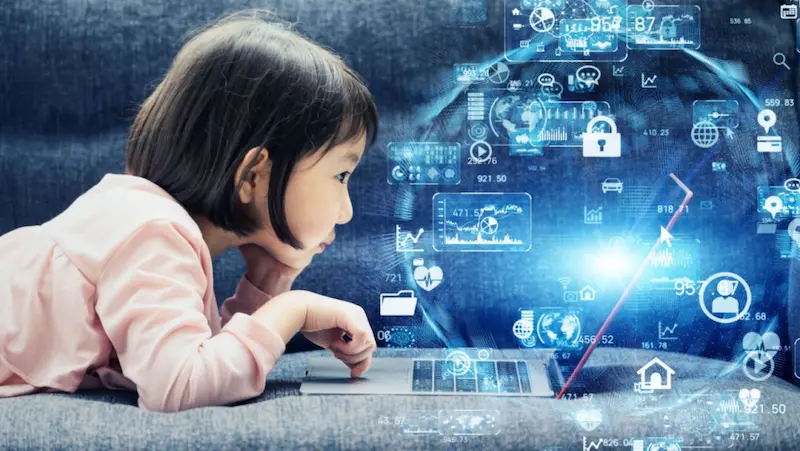
 We are an army of educators and passionate learners from BrightChamps family, committed to providing free learning resources to kids, parents & students.
We are an army of educators and passionate learners from BrightChamps family, committed to providing free learning resources to kids, parents & students.



